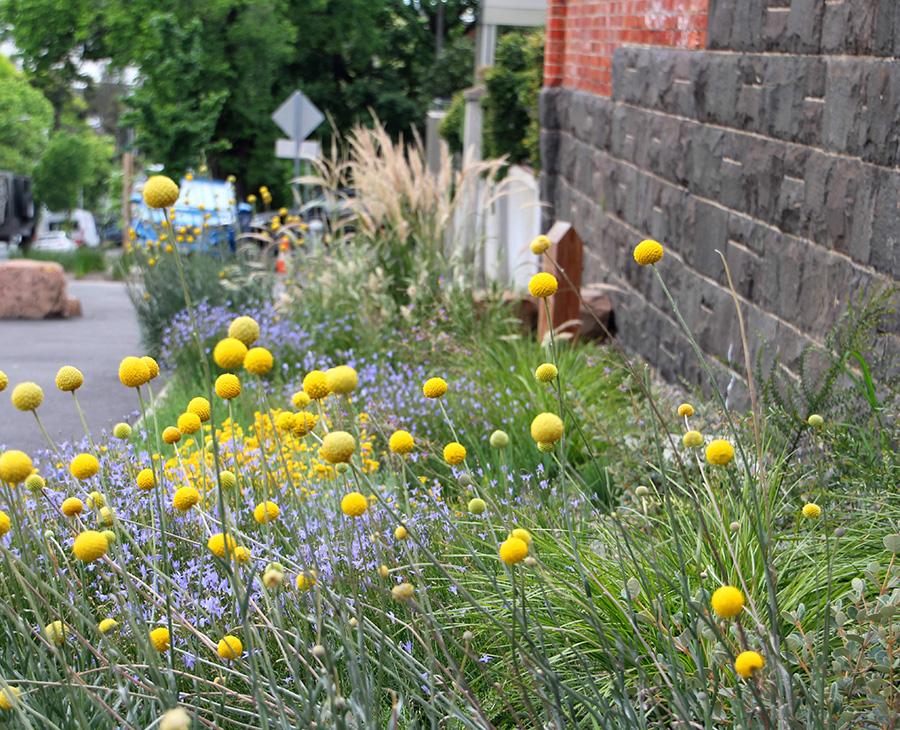Congratulations to the seven successful projects that were awarded as part of the Habitat Grants 2020 program. Projects were completed by January 2021. Read about their habitat projects below.
This habitat greening project will help create a wildlife corridor between Warun Biik Linear Reserve Park and JJ Holland Park. The project included a revitalisation of existing garden beds with local plants to create a habitat haven for birds and insects.
Whilst there are already a number of established trees present, the owner s corporation has enhanced structural complexity by integrating new plantings of ground covers, shrubs and cascading plants. This includes rock corea (Correa glabra), long-hair plume grass (Dichelachne crinita) and chocolate lily (Arthropodium strictum).
In-ground bird baths filled with pebbles and rocks were installed to provide water for both birds and insects.

This owner's corporation has been dedicated to turning their inner-city complex into a thriving green oasis. In particular, the large embankment and communal walkway has been transformed with 400 square metres of new greening for the community and local wildlife to enjoy.
Indigenous shrubs such as Austral indigo (Indigofera australis), rosemary grevillea (Grevillea rosmarinifolia) and and rock correa (Correa glabra) will be planted throughout these areas.
A stormwater harvesting system will keep the newly greened areas flourishing all year round. The new space also includes a communal herb and citrus garden for residents to tend and harvest at their leisure.

This habitat project sees heavily shaded, mostly bare garden beds transformed into a connected, understorey habitat garden. The goal of this project was to encourage greater usage and ownership by residents, as well as create habitat and a food source for native fauna.
Dense new native foliage has been integrated to fill in gaps and supplement the existing understorey planting that comprises predominantly non-flowering hedges and shrubs. This has included the Correa and Lomandra species. There is opportunity for additional local flowering plants such as chamomile sunray (Rhodanthe anthemoides), clustered everlasting (Chrysocephalum semipapposum) and coastal fan-flower (Scaevola calendulacea) to be planted in the future to increase diversity and habitat value.
Bird baths and a new irrigation system have also been installed. The community have reported more bird sightings since the creation of the habitat planting.

This project seeks to rejuvenate the communal garden inside the historic fire station on Curzon Street, North Melbourne, which was built in 1894. Funding was awarded to Phase 1 of this greening project which involved the replacement of contaminated soil in beds, the weed-ridden lawn and biodiversity-poor woody shrubs.
The body corporate is striving for a minimum of 60 per cent local indigenous plants in the garden beds, with all plants contributing to supporting local wildlife.
To achieve this, fences covered by a mix of climbers, including the indigenous purple coral pea (Hardenbergia violacea) which provides food resources for native bees and birds. Plants used in the garden bed include cut-leaf daisy (Brachyscome multifida) and spiny-head mat-rush (Lomandra longifolia), both attracting butterflies.
Plants are establishing well since planting in November 2020 and excitingly, residents have begun to observe birds, native bees and butterflies visit the site.
Additionally, the refreshed space has encouraged residents to use the ground floor space for relaxing and socialising.

With approximately 600 residents, the body corporate at Yarra Point has a vision to create a biodiverse indigenous environment that is full of colour, movement and interest establishing a green oasis for people and indigenous fauna to enjoy.
In this area, approximately 355 square metres of new greening has occurred over two levels. Existing communal gardens on level 5 have been rejuvenated with an extensive plant palette consisting of native and indigenous climbers, trees, shrubs, grasses and ground covers, including an indigenous bushfood section. Species planted include pale vanilla lily (Arthropodium milleflorum) and ruby saltbush (Enchylaena tomentosa). Since being planted, the communal gardens have become a pollinator haven with an abundance of flowering plants.
At ground level, empty garden beds have been planted alternating with silver banksia (Banksia marginata) and hop goodenia (Goodenia ovata), with indigenous grasses and ground covers interspersed throughout. The body corporate also has plans to plant a suitable climber on the back wall such as small-leaved clematis (Clematis microphylla).

Located in a hot, west-facing location, this ambitious greening project demonstrates how to achieve a sustainable native garden in our warming climate.
A substantial area in front of the property is largely lawn and lends itself to the establishment of more canopy. Two trees have been planted to increase canopy cover and provide shade.
Plants have been carefully selected for suitability for drier climates. This included a variety indigenous wildflowers and grasses such as golden billy-buttons (Pycnosorus chrysanthes), kangaroo grass (Themedia triandra) and pussy tails (Ptilotus spathulatus).
Sections of lawn have been transformed into a lizard and insect habitat haven with layered rocks, logs, stones, leaf litter granitic sand and grasses.
Additionally, seating has been installed to create an inviting space for residents to relax and immerse in the habitat garden and wildlife that it attracts.

Set within a beautiful historic building in East Melbourne, Eastern House is a 13 unit residential complex that encompassed a beautiful garden but with limited native vegetation.
Since receiving the grant from the Habitat Grants 2020 program, the owners corporation has integrated native grasses and groundcovers to the rear wall of the property including Burchardia umbellata (milkmaids), Brachyschome white (native daisy) and Rytidosperma setaceum (bristly wallaby grass).
Wires have also been installed at the back wall to support native climbing plants in the future and maximise greenery in such an underutilised space.







